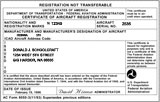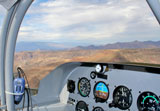|
Experimental Airworthiness CertificatesGeneral InformationExperimental airworthiness certificates or special flight permits must be issued in order to leagally operate any U.S. registered aircraft that does not have a current standard airworthiness certificate or special airworthiness certificate. Operations requiring the issuance of experimental airworthiness certificates include those involving flight tests of certificated aircraft that have undergone design changes. A experimental certificate may be issued to an aircraft located in or outside of the United States that is intended for continual operation in another country when it meets the following requirements: - The Civil Aviation Authority (CAA) of the country in which the aircraft is located or intended to fly has authorized operation of the aircraft. - The FAA Flight Standards Office will have appropriate oversight of the aircraft during the period of operation. If an experimental certificate is issued to an aircraft located in or outside of the United States for time-limited operations in another country, it will be accompanied by appropriate operating limitations that have been coordinated with the responsible CAA before issuance. The requirements for issuing experimental airworthiness certificates are contained in FAR's 21.191, 21.193, and 21.195. Type certification programs include type certificates (TC) and supplemental type certificates (STC), as well as amendments to either. FAR 91.319 prescribes operating limitations that are applicable to all aircraft having experimental certificates. In addition, the Administrator may prescribe other limitations as may be considered necessary. Experimental military aircraft built under a military contract and identified by military aircraft ID marks do not require registration or the issuance of experimental certificates for flight testing or demonstration prior to acceptance by the military. However, aircraft of military design built independently by manufacturers and not having military identification are required to obtain FAA registration and an experimental airworthiness certificate because such aircraft are considered civil aircraft. The FAA must determine that the aircraft displays nationality and registration marks in accordance with FAR 45.21 and that the word “EXPERIMENTAL” is displayed in accordance with FAR 45.23.
Multipurpose Experimental Airworthiness CertificatesExperimental airworthiness certificates may be issued for more than one of the following purposes: - Experimental Special Purpose - Experimental Light Sport - Experimental Amateur Built - Experimental Exhibition or Air Racing - Experimental Research and Development When more than one purpose is requested, the FAA/DAR will make sure that adequately controlled conditions exist and are specified in the operating limitations. When issuing an experimental airworthiness certificate for the purposes of R&D, showing compliance with regulations, crew training, or market surveys, the certificate will be made effective for only the length of time reasonable to accomplish the applicant’s program, and not to exceed 1 year. The issuance of multiple-purpose certificates for R&D and showing compliance will be limited to Production Certificate (PC) and Approved Production Inspection System (APIS) holders. This may be extended to modifiers only when adequately substantiated, for example complex programs. Applicants for a multiple-purpose certificate must justify the requested purposes to the satisfaction of the FAA/DAR.
EligibilityFor an aircraft to be eligible for an experimental airworthiness certificate, it must be registered and the applicant must satisfy one or more of the purposes stated in FAR 21.191. An aircraft that has a Dealer’s Aircraft Registration Certificate may be issued an experimental airworthiness certificate so the manufacturer can perform required flight tests, as well as for purposes incidental to the sale of the aircraft. In the latter case, the FAA must ensure that the requirements of FAR 21.195 are met.
Program LettersTo ensure compliance with FAR 21.193(d), the FAA requires the applicant to submit a program letter . The following will be described in the applicant’s program letter: (1) Purpose of Experiment, FAR 21.193(d)(1). An applicant must submit a program letter that describes the purpose of the experiment and the aircraft configuration, and outlines the program objectives. The letter must be detailed enough to permit the FAA to prescribe the conditions and limitations necessary to ensure safe operation of the aircraft. The letter should not describe everything in minute detail. The use of the same aircraft for overlapping programs is not precluded and the program letter can outline one or more programs. Upon showing compliance with FAR 91.319(b), the aircraft can be used to support other aircraft in the program or other experimental programs the manufacturer/applicant has underway, for example, to support flightcrew movements, to be used as a chase plane, to carry spare engines, etc. NOTE: A new program letter will be required when significant changes to the aircraft configuration and program objectives are planned. (2) Time or Number of Flights, FAR 21.193(d)(2). The applicant’s program letter must include the estimated time or number of flights required to accomplish the program. The FAA will evaluate the request in comparison to the program in order to establish an appropriate time duration for the special airworthiness certificate. (3) Areas. In the program letter, the applicant must provide sufficient detail to describe the areas over which the proposed flights are to be conducted. It is the responsibility of the FAA to establish boundaries of the flight test area, as well as takeoff, departure, and landing approach corridors that minimize hazards to persons and property in densely populated areas or congested airways. (4) Describe Aircraft Configuration. Except for aircraft converted from a TC, the applicant must describe the aircraft’s external configuration. The use of three-view sketches and three-dimensional photographs is acceptable. Click here to download a Sample Program Letter that you can use or expand upon as needed.
Demilitarization of Former Military AircraftFormer military aircraft should be demilitarized prior to application for experimental airworthiness certificates. It is not possible to define what the final configuration of these aircraft will be following this demilitarization. Because the demilitarization process most likely will involve a change to the aircraft configuration, FAA representatives will not consider an application for airworthiness certification unless demilitarization has been completed. It is the policy of the U.S. Department of Defense (DOD) that surplus U.S. military property designated as arms, ammunition, implements of war, and other military items will be demilitarized to the extent necessary to preclude the unauthorized use of these military items. This DOD policy mandates that tactical, fighter, and bomber aircraft will be demilitarized to the extent that will render the aircraft not airworthy. However, the DOD does release a limited number of tactical, fighter, and bomber aircraft for operation in R&D programs. This policy is not applicable to military trainer, observation, or liaison aircraft. NOTE: This does not mean that all other U.S. surplus military aircraft should have been rendered not airworthy. For example, some U.S. military aircraft that were sold to other countries may be available for public sale. These aircraft are subject to the normal import requirements. Former military aircraft imported from any other country require an import permit issued by the Department of the Treasury, Bureau of Alcohol, Tobacco, and Firearms (ATF). This permit is granted by the ATF using ATF Form 6, Application and Permit for Importation of Firearms, Ammunition, and Implements of War.
Aircraft Equipped with Ejection Seats, Ballistic Parachutes, or Jettisonable StoresFormer military aircraft with experimental airworthiness certificates for the purpose(s) of R&D, exhibition, or air racing, may be eligible to operate with functional ejection seats. Only aircraft certificated for the purpose of R&D may be eligible to operate with functional jettisonable external fuel tanks or stores. The following requirements must be met in order to have these systems operational: - The applicant must provide objective evidence that the airport manager of the airport where the aircraft is based has been notified regarding both the presence of explosive devices in these systems and the planned operation of an experimental aircraft from that airport. - Jettisonable external fuel tank(s) or stores systems must be maintained in accordance with the manufacturer’s procedures and inspected in accordance with the provisions of the FAA Flight Standards District Office (FSDO) approved inspection program for the particular aircraft. The FAA will verify that there is a record entry indicating current serviceability of the jettison system(s). - Ejection seat systems must be maintained in accordance with the manufacturer’s procedures and inspected in accordance with the provisions of the FSDO approved inspection program for the particular aircraft. The FAA will verify that there is a record entry indicating current serviceability of the ejection system, including the status of any dated shelf-life items. - The applicant must have provisions for securing the aircraft to prevent inadvertent operation of the jettison and/or ejection systems whenever the aircraft is parked. - The applicant must have provisions that provide for clear marking and identification of all explosive devices used in ejection seats, ballistic parachutes, and jettisonable systems. Aircraft markings should be applied externally and indicate that the aircraft is equipped with explosive devices. Click here for general information about experimental flight tests
|









